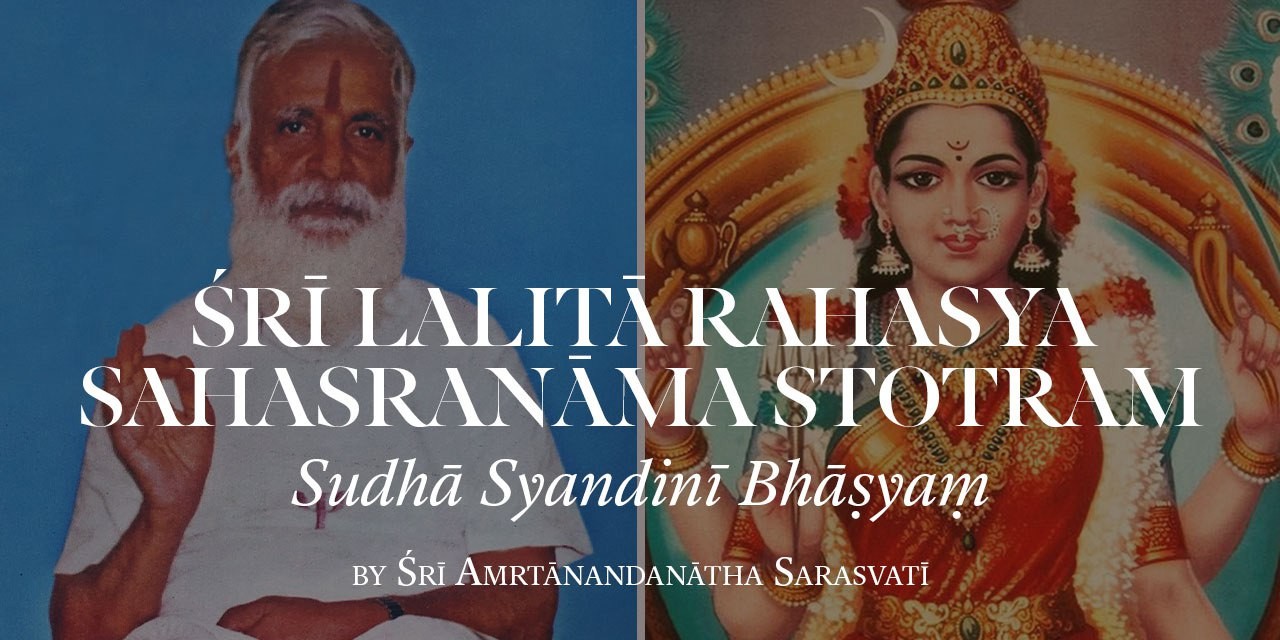- Edited

60) Kadaṃbavana-vāsinī
The central point of the Śrī Cakra is known as the bindu sthana, which is an ocean of milk. In that, there are five vulvas which yield all desires, and so are the kalpavṛkṣas. There is the row of Kadamba trees, in the centre of which lies the house of Cintāmaṇi. This is how Bhairava Yāmala describes Lalitā as resident in the forest of Kadamba trees.
(s.) According to the derivation “kam damayati iti kadambaḥ” kadamba means the place where no breeze blows. Breeze is the property of air, and its characteristic is the sense of touch as well as breathing. The esoteric meaning is that Lalitā is known by the devotee at a place and time where all contact with the sensory world ceases, where the winds of desires have stopped blowing, and because of that, the breathing itself has come to a stand still. The mind and thoughts drive the breath, while breathing drives the thinking process. You have to stop one to stop the other. Hatha yoga relies on stopping the breath to stop the thoughts. The ascetic discipline of brahmācārya makes the mind one pointed on the release of libido which is denied a physical outlet and so has to find a spiritual outlet. A mind which is one pointed, or concentrated, will flow into nothing ultimately, as it loses interest in the object of meditation.
It finds tranquility as the next best alternative to pleasure principle, and when it tries it whole heatedly, finds that it is a much superior pleasure than the tense happiness of this or other worlds.
Sādhana
A daring departure from the customary asceticism is proposed and verified by tantra. Whereas the ascetic disciplines forbid sex altogether, tantra advocates its liberal use as a means of transcendence. The ascetics focus their minds in the Sahasrāra. The tantric realises that such a focus is impossible through effort, but that it has to happen by itself. So he focuses on the lowest, Mūlādhāra centre. Due to the intense concentration there, and also the fact that a partner of the opposite sex is used to couple, be it in a non-moving posture, his self denial of ejaculation centres the mind only on one thing, namely, how to ejaculate without a physical release.
Such a release from tension happens not when the erection is there, but when the erection has subsided by itself half way. The tantric reaches this state of one pointedness much faster than the ascetic. The mental ejaculation of the male and female tantrics yields a torrent of revelations, and when this flow stops, the mind becomes a lake of nectar, tranquil1, and no breezes of desires can possibly disturb that state.
The ascetic is trying to reach desirelessness by forbidding sensual thoughts. This can no doubt be done, but it is a very difficult process for the normal person. The reason is that there is a vicious loop here. The nature of the vicious loop that unless one is totally desireless, one cannot be in Sahasrāra; and unless one is in Sahasrāra, one cannot be desireless. The route to open this loop lies not in the plane of Sahasrāra where the realised soul is, but in the lower planes where the ordinary human beings are. The place where one begins the sādhana depends on the normal center of Kuṇḍalinī in the aspirant. For most of us, who consider the world we see as the only reality the Kuṇḍalinī, the power which can give us liberation is sleeping with "three and a half coils circling the penis in the male and the clitoris in the female."
So the best way is to begin the sādhana from where you are. Accept that we are sex located, sex driven, and offer the same shamelessly to the divine as one of its own expressions. Overcoming shame is no mean achievement; a large chunk of ego has to be destroyed before one can unrobe in front of another. When divinity can be brought into the realm of sex, there then is the hope of transcendence from desires totally. Divinity brings in its wake discipline. Control of ejaculation in a state of tumescence leads to a maddening one pointedness of the mind. All other elements of coitus except physical movement and ejaculation being present, the mind shakes free from its thoughts which are only contributing to further tensions. The mind discovers that there is supreme pleasure in silence. It is in such a state that the upward journey of Kuṇḍalinī begins, climaxing in Sahasrāra, as Samādhi.
Source: Śrī Amṛtānandanātha Saraswatī "Sudhā Syandinī Bhāṣyaṃ" Typed Manuscript
(an incomplete commentary on Lalitā Sahasranāma)

